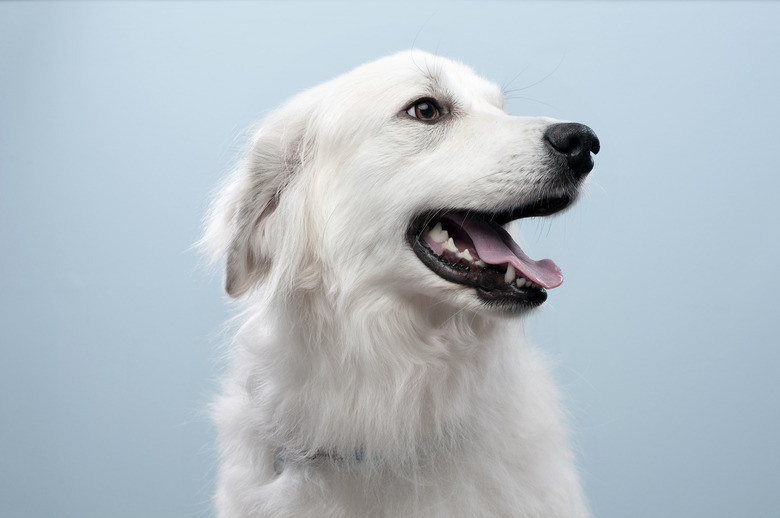What Are The Causes Of White Dog Hair Turning Red?
We may receive a commission on purchases made from links.
Disclosure: At Cuteness, we are committed to being the go-to resource for pet owners and animal lovers. We only recommend products we think our audience will love. If you purchase something by clicking on one of these links, we may receive a small commission of the sale and the retailer might receive some data for accounting purposes.
Seeing pink hair on dogs isn't terribly shocking these days . . . but what if you see pink dog fur on your dog when you didn't apply dye to it? Newly pink, red, or rust-colored fur on dogs is sometimes an indicator that something is wrong with the surface of their skin, and the issue should be investigated, addressed, and treated as soon as possible. Fortunately, the causes of dog fur turning a rust color are generally nothing too serious to worry about, and things can be returned to normal within days of treatment.
Why is my dog red?
Why is my dog red?
One of the most common causes of pink hair on a white dog is called yeast dermatitis, otherwise known as a yeast infection. All dogs, like people, have a healthy amount of bacteria and fungus living on their skin. Yeast infections occur when an overabundance of fungus is produced, which often results in itchiness and may cause a dog to lick or scratch the area. A dog's hair can take on a reddish hue as the result of a yeast infection thanks to the constant licking done to soothe irritation. This licking may exacerbate the problem further as yeast thrives in wet, humid areas.
While some redness is caused by skin issues, other examples may be typical of a certain dog, or even specific breeds. You've probably seen tear stains on the faces of some dogs, which cause the hair just below the inner corners of the eyes to become brown or rust-colored. These stains are caused by porphyrins, which contain iron molecules that a dog's body passes through the urine, saliva, and tears, according to MedVet. While most cases of tear staining occur as a result of healthy tear production, some may be the result of issues with the eyelid, like tightness in the medial canthal ligament.
Treatment options for red fur
Treatment options for red fur
In order to remove redness caused by a yeast infection, you'll first need to identify the cause, which can be done with the help of a veterinarian. Because yeast infections are fungal infections, they are usually improved by topical treatments, like antifungal shampoo or ointment, or oral medication. Sometimes, home remedies which rely on apple cider vinegar, which is a natural antifungal, can improve an infection, and the reddish stain on fur will go away over time. For dogs who have allergy-related infections, a dietary change may be in order, which can be done with the help of a doctor.
Having a dog with light fur is incredibly helpful for spotting illnesses like yeast infections or parasites as it can make the redness more easily visible, which will clue you into the issue relatively soon. This can also help you see where the issue is arising, which may clue you in to the possible causes. If you see your dog fur turning a rust color around the eyes, it's recommended that you wash the area and dry it thoroughly. You can use a washcloth with warm water for mild cases, or if you make upkeep part of your regular routine, or you can try eyewash rinses and treatment pads, which are available at most pet stores.
Redness prevention tips
Redness prevention tips
Because pink dog fur staining is caused by either saliva or tears, the best way to keep your pet's white fur looking light is to keep their skin clean and very dry. This goes for dogs with tear staining issues, and canines who have red or rusty paws, ears, or genitals from constant licking. If your dog experiences frequent yeast infections on the paws or ears, you can try drying his feet after wet walks, and rubbing his ears dry after a bath or swim. For dogs with tear staining issues, keeping the hair around their eyes and nose as short as you can will reduce discoloration.
Treating your dog’s red fur
Treating your dog's red fur
If you notice your dog has red fur, then the first thing to do is contact your veterinarian. As long as they give you the go-ahead, then you can try at-home remedies to treat your pup. You could order a two-pack of Bragg Organic Apple Cider Vinegar, for example, or purchase antifungal and antibacterial dog shampoo. The shampoo contains Chlorhexidine Gluconate and Ketoconazole and can eliminate skin infections like fungus, bacteria, yeast, ringworm, pyoderma, and hotspots.
If the problem is occurring around the eyes, then try Burt's Bees for Pets Dogs Natural Eye Wash with Saline Solution, which is free from fragrances, colorants, harsh chemicals, and sulfates and is safe for all puppies and dogs. Remember to keep your dog's hair trim by taking him to a groomer regularly and using Pets First Pet Grooming Scissors in between visits. As long your dog stays still for you, you can feel free to cut his hair at home with these scissors.
